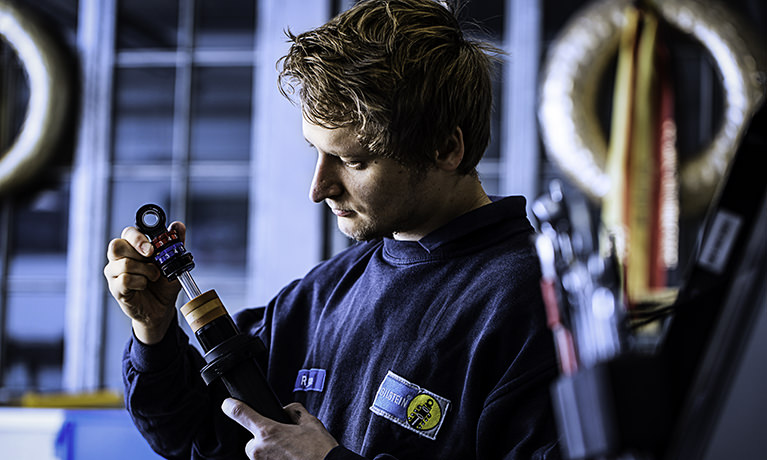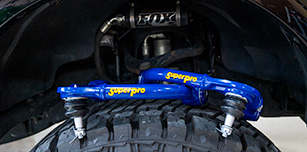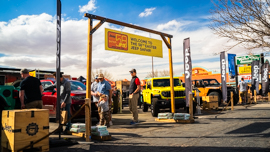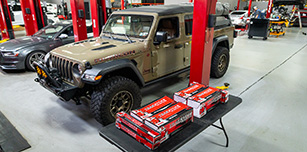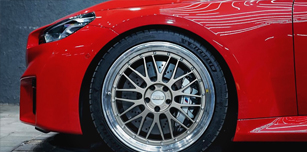Photos Courtesy: Tein USA, Bilstein
A noticeable vehicle upgrade can be made with the installation of a set of upgraded suspension dampers, but do you really know what you’re buying and what it can do for you?
In the performance enthusiast world, people often buy suspension products because they’ve seen them advertised somewhere, or experienced performance benefits on another car, perhaps owned by a friend – or nemesis – but don’t necessarily understand what it is they’re buying or why they’re spending enough cash to cover a mortgage payment on said product.
The non-enthusiast might call these components shocks, but in reality damper is the technically accurate term. Damper operation and construction is so extremely intricate and detailed that the term shocks is inaccurate. In reality, the suspension damper has one specific job – to control the motion of the suspension’s spring at all four corners of the vehicle, but the dampers also affect ride comfort and ultimately vehicle performance through this action.

Think back to the old Charlie Chaplin movies where the car bounces endlessly down the road; that’s what your suspension would do with only springs installed and without the addition of a damper to modulate that oscillation. With dampers in place, however, the vehicle’s suspension can be controlled and optimized for the specific operating circumstances.
Front Street recently had the chance to gather input from two of the damper world’s leading manufacturers – Tein USA and Bilstein – to discuss the simple, yet complex components tasked with keeping your car tied to the road.
We asked the questions, then let the experts have the floor…
Front Street: What are some of the hallmarks of a quality suspension damper?
Team BILSTEIN: A high quality damper will be engineered with: application specific tuning, precise machining, high quality components, and stringent quality control held to meet or exceed OEM standards. Many of our dampers have been rigorously tested and tuned on our Papenburg and Nürburgring test facilities. By conducting these trials for each application, we can validate our components and ensure the standard has been met.
Paul Pilpa/Tein USA: This will vary by manufacturer, but for TEIN we have three goals: safety, high quality, and reasonable pricing. Most important is that our kit offers construction that exceed the standards of even factory supplied suspension. Our customers’ safety is paramount. We select materials that we know provide the best performance and longevity. We also pride ourselves in providing some of the best metal surface treatments so that their suspension continues to function for many years. The only way to achieve the high quality we want is by continued testing and developing through motorsports experience. Our engineering knowledge gained in motorsports trickles down directly to all of our products. And we don’t want our suspensions to be exclusive to just one type of customer. We want all customers to be able to enjoy their driving experience. The only way to do that is to make our products accessible to customers over a wide range of income brackets.

Front Street: How does a damper work to control spring motion?
Team BILSTEIN: The shock absorber is an energy transducer, which changes kinetic energy into heat energy induced by liquid friction. Precisely defined valve flow in the piston (and in some cases at the bottom of the damper), slow down the kinetic energy rapidly, so that spring vibrations are reduced immediately. Controlling the wheel movement is key to obtaining comfort, safety, and performance.
Paul Pilpa/Tein USA: First, it’s important to understand that the purpose of the spring is to support the weight of the vehicle (known as sprung mass). Therefore, we aren’t just trying to control spring motion. We’re trying to control vehicle motion. However, springs are also necessary to allow lateral wheel movement. Rigidly mounted wheels will make a car incredibly uncomfortable as it passes over road imperfections. Wheels that are given freedom to move up and down allows some level of comfort and vibration control.
The damper’s function is critical during suspension setup. It must convert both the suspension motion and vehicle motion, which is kinetic energy, and convert it to another form of energy. That form of energy is heat. It is the easiest conversion for kinetic energy. Because of this, our dampers are subjected to high heat because of this energy conversion.
Front Street: How does your engineering team develop the proper damping rates for each particular application?
Team BILSTEIN: BILSTEIN engineers acquire each vehicle; build direct fit take-apart prototypes, test and tune extensively as a team to achieve: function, safety, quality, and performance. BILSTEIN’s testing facilities include Papenburg, Nürburgring (GER), Poway (CA) and Hamilton (OH). Simply matching characteristics found through dyno testing are not sufficient. Each application is road, track, or trail tested in a development process unique to the automotive aftermarket.
Paul Pilpa/Tein USA: This is where our research and development comes in. We cannot simply choose a spring rate and valve a damper for it, then call it a suspension kit. We go through extensive testing for each application. Vehicle weight (corner weight, front & rear balance, etc.), as well as what type of suspension kit we are trying to make become the factors for us when selecting our damper valving. We constantly road test a particular vehicle to achieve a good balance of performance and ride quality.
For racing applications, we have to spend even more time when engineering a suspension kit. In circuit racing, for example, we must factor not only vehicle weight, but also what type of tire (size as well), and circuit surface conditions. Ride height is also a factor, but that is dependent on what most of our customers require. N1 racing requires very high spring rates and very short damper stroke lengths. This compliments the type of tire allowed in the series (racing slick) and the very low ride heights these cars are set up with. Valving for such a racing series differs greatly from rally, which have much longer stroke lengths and ample ground clearance requirements.

Front Street: For example, how does a damper for a drag racing application differ from one that will be used in a performance street application?
Team BILSTEIN: Different applications require different suspension characteristics. For example a dragster front shock uses very low rebound and high compression to compensate for front wheel lift during the launch. Street applications use high rebound and low compression rates. The differences in forces applied to the chassis dictate the requirements (e.g. spring rates, motion ratios, valving) for drag and performance street vehicles.
Paul Pilpa/Tein USA: Drag racing suspension setups will vary, depending on whether it’s a front-wheel drive vehicle, or rear-wheel drive (or all-wheel drive). The goal is always the same for either drive type- get the most traction available to the drive wheels (the wheels under power) and to limit weight transfer to the non-drive wheels.
Front-wheel drive drag cars typically have very stiff rear suspension to reduce the transfer of weight out back and keeping it over the wheels under power. This would make for a very uncomfortable ride for the street.
Rear-wheel drive drag cars don’t need to be all too different from street suspension. Altering the rebound rate to a stiffer setting for the rear suspension helps reduce teetering (back and forth weight shift) and allows the driver to stay on throttle more consistently and for the duration of the run. Springs do not necessarily need to be incredibly stiff.
Front Street: Are there differences in the oil used inside the damper depending upon the application?
Team BILSTEIN: Yes, BILSTEIN uses several different types of oil that can vary in viscosity and heat rating.
Paul Pilpa/Tein USA: For most of our suspension kits, no. Differences from other brands of suspension? Yes. Our damper oil is made to our specifications. This allows us the ability to valve our dampers properly and consistently. Otherwise, if we used various grades of damper oil, performance will be inconsistent. Our Gr.N rally suspension is the only exception, since these dampers are subjected to much higher temperature extremes. We use a damper oil that is capable of reaching temperatures over 300 Celsius, but must also perform well in subzero conditions.

Front Street: How does an adjustable damper change the rate of damper motion throughout its range?
Team BILSTEIN: Adjustability of a suspension comes through three ways; the use of active suspension systems, digressive valving, or manual adjustment. Active Suspension Systems (e.g. BILSTEIN B4 Series) can control the vehicle’s ride height and dampening rates via the onboard computers and sensors. This system is fully active in real time. Digressive pistons in conjunction with a series of spring steel plates (shims) control the flow of oil through the compression and rebound ports of the piston (also known as digressive valving). This system is velocity sensitive, which creates a self-adjusting valve stack that creates a compromise between comfort and performance. Manual adjustment (e.g. BILSTEIN B16 and Clubsport) controls the damper valving by changing the diameter of a bypass orifice around the piston and therefore creating a different valving rate.
Paul Pilpa/Tein USA: Our adjustable damping is done mechanically. Using a needle valve, we can either constrict or open up damper oil flow through an orifice (separate of the piston valve), effectively altering the damping rate. Constricting oil flow will make it slightly harder to move the damper on both compression and rebound (mainly rebound). Opening oil flow allows for an easier movement. That is how we can increase damping force. However, this does not alter, or limit, the damper’s total motion rate from either extreme (fully compressed and fully extended).

Front Street: Some dampers are adjustable for rebound only, and some are adjustable for both compression and rebound. Are specific types of adjustable dampers recommended for particular applications, and why?
Team BILSTEIN: Vehicles that require complete control and comfort, are best with a computer controlled air-spring system (e.g. Mercedes S-Class, W222). For high performance direct-fit replacements, the digressive self-adjusting system works best. Manual adjustments are best for off-road applications, performance oriented suspension systems and professional racing.
Paul Pilpa/Tein USA: Usually, reboundonly adjustability is the most common. For most customers, this makes it easier to tune the dampers with a noticeable difference in damper performance. Although we state as rebound only, there is a slight change to compression adjustment with our dampers. After all, our needle valve adjuster has to control oil flow in both directions.
We don’t typically recommend customers to purchase a 2-WAY adjustable damper for street use, mainly because it’s an unnecessary cost for them. It also takes some time to set up compression and rebound that suits each customer. That doesn’t mean that you’ll never find one of our SUPER RACING damper kits used on the street. It’s just that we know most of our customers may not be able to justify having separate compression and rebound adjustment for roads with varying conditions. Having an EDFC (Electronic Damping Force Controller) system changes that, since you can alter damping in real-time, from the driver’s seat. Otherwise, having to go out and manually adjust each compression and rebound setting is a time-consuming matter that most consumers may not want to deal with.
Front Street: How is a damper developed for ride quality versus performance? For example, what parameters are chosen to make the damper feel “softer” for a luxurious ride compared to a damper set up more firmly for performance?
Team BILSTEIN: BILSTEIN aims to provide a quality damper that gives performance and safety at any level. Our extensive product range provides drivers many options that suit their needs. BILSTEIN Engineers first test a stock vehicle to establish a benchmark. Then undesirable characteristics are adjusted and the shock is tested to meet comfort, control, and safety settings. Internal settings of the dampers and spring rates are changed as the damper becomes more performance based. These piston and spring rate changes are what drive the overall suspension performance. Features like double or single adjustability allow for further fine-tuning. The difference is evident when comparing our B4 OE Replacement (meant to restore ride comfort) with our BILSTEIN Clubsport Series (more suited for performance driving).
Paul Pilpa/Tein USA: This is what separates each manufacturer from one another. We offer many different suspension kits, even for just one specific vehicle. In our case, we factor what types of features we feel a customer finds important, as well as what type of budget we feel the customer has. This directly affects how we will set up damping and spring rates for each application. For example, our STREET BASIS Z coilovers are aimed towards consumers that rely on their vehicle as their sole means of transportation. Knowing that this means the car is strictly a street car, we select uprated spring that won’t be very aggressive. Then we can valve the dampers to match the type of performance we feel suitable for this type of kit.
For kits like our Comfort Sport coilovers, you’ll see that it has a very limited application list, typically luxury sedans and coupes. This is because we know most of these consumers with these very vehicles aren’t looking for a race suspension. Still, we do our best to offer a kit that will provide a level of increased performance, but not to the point of discomfort to the driver/passengers.
Ride quality and performance aren’t necessarily two different goals. We always try to offer a suspension kit that will provide a mix of both great handling performance and an uncompromising ride feel.
Front Street: How does the damper’s housing affect its rate of heat transfer? Many dampers today are built with steel housings, but some racing dampers use aluminum housings. Can you explain why?
Team BILSTEIN: Even normal driving creates heat within the damper. It is the damper’s housing that is responsible for transferring heat from the oil to the outside air. Without the transfer of heat from the body, performance will suffer due to the thinning of oil (which changes desired damping characteristics).
For certain applications, aluminum housings (e.g. BILSTEIN MDS) are used. Besides weight savings, aluminum housings transfer heat faster because of its metallurgic composition, thus creating greater cooling capabilities.
Paul Pilpa/Tein USA: Heat transfer is very important for a damper to function properly. After all, the main purpose of a damper is to convert kinetic energy into another form of energy, which in this case is heat energy.
Without sufficient cooling, or heat dissipation, a damper’s performance will easily fade, as damper oil viscosity decreases (thins out). This essentially reduces damping force.
Monotube dampers typically exhibit the best heat dissipation since its single-wall construction means heat from damper oil transfers quickly to the damper body, therefore making it easier to radiate this excess heat externally by airflow on and around the damper. Inverting a monotube damper will only expose part of the damper body, which technically reduces its ability to radiate heat out of the damper.
Twin-tube dampers, while being double walled, are still able to radiate heat since some damper oil transfers to the outer tube.

Front Street: Many dampers today are built with steel housings, but some racing dampers use aluminum housings. Can you explain why?
Team BILSTEIN: For certain applications aluminum housings are used. Besides weight savings, aluminum housings transfer heat faster because of its metallurgic composition, thus creating greater cooling capabilities.
Paul Pilpa/Tein USA: Steel bodied dampers make for a more affordable construction, while still being able to offer high strength and easier construction (and potential repairs). We do have greater design freedom for our dampers using steel than compared to other alternative materials.
While being more cost-effective to manufacture (and in turn more affordable to the consumer), there are many instances where steel is still the most appropriate medium to construct our dampers.
MacPherson strut type suspensions are another example of dampers that require great strength due to the types of stresses that are inherent to their design. They not only provide a mounting solution for a coil spring and damper, they are also integral to the chassis, supporting the wheel and brake assembly, and also a majority of the vehicle’s weight (sprung mass).
Rally racing is the most abusive form of racing and such environments require a lightweight damper body, many of which are MacPherson strut designs, capable of exhibiting very high lateral stress loads and must be repairable (to an extent). Therefore, steel will always be used for such applications.

Front Street: Please explain the differences between the four types of dampers.
Team BILSTEIN: In a twin-tube shock absorber, as the piston rod cycles, the displaced oil volume is forced through the base valve into the outer tube. On the rebound cycle oil is again pulled through the base valve from the outer tube into the inner tube. In some cases the base valve has additional valving in conjunction with the working piston. Advantage to this design is the capability to weld mounts directly onto the outer tubes.
In the gas-filled monotube BILSTEIN uses nitrogen gas to prevent cavitation at the working piston. Additionally, the monotube design allows heat to dissipate through the single tube construction. As the piston rod cycles the displaced oil volume forces the floating dividing piston to move up and down. Advantages of the monotube design are infinite tuning capabilities due to the deflective piston design, and long life due to reduced heat and friction. In addition monotube shock absorbers can be oriented in any direction and still function to full capability.
The inverted monotube is a strut insert mounted upside down in the strut’s stand tube. Benefits of the inverted monotube design are increased side load capability, decreased thermal loading, prevention of shaft deflection, and internal bumpstops.
Lastly, external reservoir shocks provide the following benefits additional oil volume to prevent damper fade, the external reservoir provides another heat dissipating surface exposed to the outside air, the external reservoir can provide an additional working piston (BILSTEIN ACV) and more tuning capabilities, and by removing the dividing piston and gas reservoir from the main tube to the external reservoir additional travel will be provided.
Paul Pilpa/Tein USA: First, all of our dampers are gas (nitrogen) and oil filled.
Why we use nitrogen gas is important. A damper, by design, isn’t simply an energy converter. It is also a displacement device. The piston rod compresses into the damper, then extends. This compression displaces some volume within the damper. If we were to fill the damper completely with oil, this movement will not exist because damper oil is incompressible. Nitrogen, at a certain pressure, is compressible. Therefore, the piston rod now has room to displace into the damper body.
Twin-tube dampers, as the name implies, has two tubes. The smaller inner tube, or working tube contains a majority of the damper oil, and also contains the piston rod/valve assembly. At the very bottom of the tube is a base valve. We can tune this valve to control fluid flow into the outer tube. The outer tube, which serves as the damper body, contains some damper oil and the nitrogen gas charge.
Monotube dampers are a single tube (mono) and serve as the damper body and working tube. The other difference is that the nitrogen is separated by a free floating piston. There is no base valve for most of our monotube dampers.
External reservoirs are used for our 2-WAY or 3-WAY adjustable monotube dampers (SUPER RACING, N1, Type HT, Gr.N). *The only twin-tube damper that uses an external reservoir is our Type HG dampers. Within the reservoir is a base valve with a needle valve adjuster. This allows us to control fluid flow during compression. There is also a free floating piston within the external reservoir that separates the nitrogen gas from the oil.
Front Street: Can a damper’s characteristics be too aggressive? What are the concerns in a situation like this?
Team BILSTEIN: Yes, damper characteristics can be too aggressive. Overly aggressive damper characteristics can result in reduced ride-quality, limited suspension travel, poor vehicle control and unsafe handling characteristics.
Paul Pilpa/Tein USA: Damping can easily be made too aggressive. Most often characteristics of, let’s say, an overdamped damper, is incredibly stiff ride feel and what can be interpreted as wheel skip (where the tire loses contact with the road surface briefly).
Interesting enough, some European vehicles have dampers with slightly aggressive damping, in relation to the spring rates used, giving a very distinct ride quality.
Front Street: As you can see, there’s more to a suspension damper than simply up-and-down movement and motion control. We greatly appreciate the representatives from BILSTEIN and Tein USA for taking time from their busy schedules to assist us in compiling this article.


